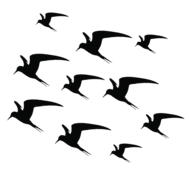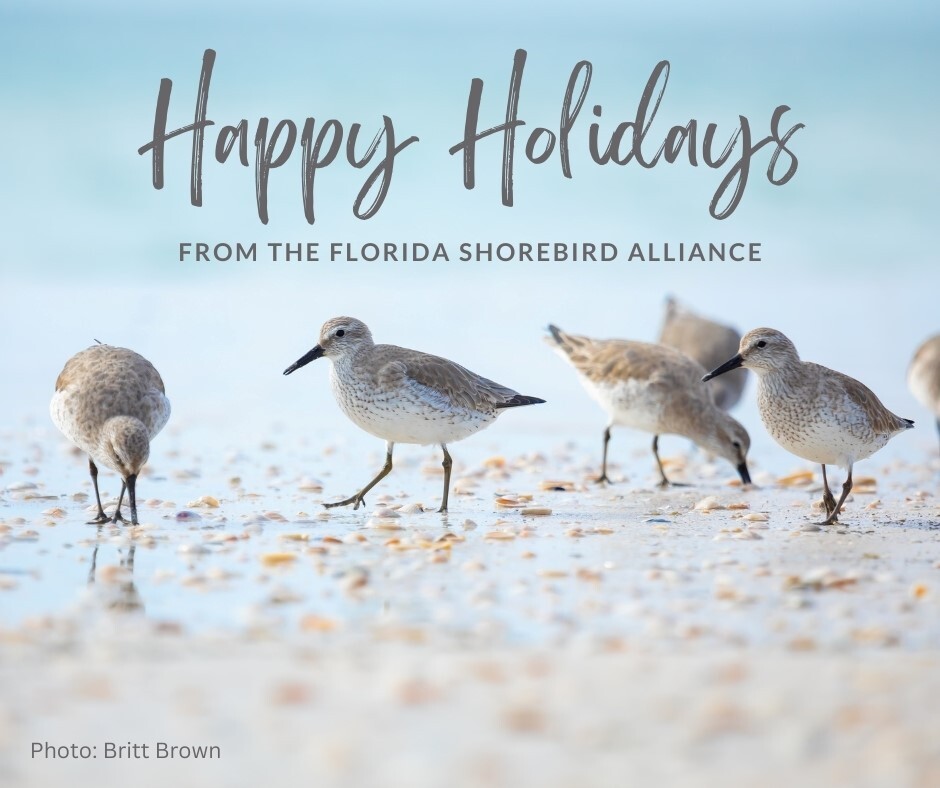Events:
December 14 - January 5: Audubon's 124th Christmas Bird Count
IBNB Guidelines Status Update
At the October meeting of Florida's Fish and Wildlife Conservation Commission, the Commissioners approved an effective date delay from September 2023 to October 1, 2024, for the Imperiled Beach-nesting Bird (IBNB) Species Conservation Measures and Permitting Guidelines. The change allows for additional time to recruit and train IBNB Permitted Monitors and to continue engaging with stakeholders in hurricane impacted areas, the private sector, and potential permittees. FWC staff will continue to focus on avoidance of impacts and evaluate existing permit applications on a case-by-case basis, consistent with existing Rule 68A-27.003.
IBNB Permitted Monitors are an important tool in conserving shorebirds and are qualified to assist FWC Incidental Take Permittees with minimizing and avoiding harm or harassment of imperiled beach-nesting birds (American oystercatchers, snowy plovers, least terns, black skimmers) during project activities.
This delay will allow more people to gain the required experience to become IBNB Permitted Monitors and ensure potential permittees have access to qualified bird monitors.
If you are interested in becoming an IBNB Permitted Monitor and would like to gain the required monitoring experience alongside skilled bird monitors during the 2024 nesting season, please fill out the online interest form. In addition to monitoring experience, individuals need to complete FWC’s online training to meet permit requirements.
The Species Conservation Measures and Guidelines are designed to be a tool for landowners, consultants, agency partners and other interested parties on how to conserve imperiled species. The IBNB Guidelines include recommended conservation measures and survey methods to promote actions that benefit these four state-listed shorebird species. These Guidelines also include options for avoidance of take, permitting options that minimize and mitigate unavoidable harm or harassment, and examples of activities likely to cause take.
Learn more about how you or your consulting staff can become an IBNB Permitted Monitor by visiting the FWC’s IBNB Permitted Monitor webpage.
Further information on IBNB Permitted Monitor Permits is available in the IBNB Species Conservation Measures and Permitting Guidelines.
If you need technical assistance with the online learning platform, please contact eLearning@MyFWC.com. Questions related to training material content can be sent to shorebird@MyFWC.com. For updates on how to apply for an IBNB Permitted Monitor Permit (applications are now being accepted), please visit MyFWC.com/IBNBMonitor.
 2022 Shorebird Abundance Estimates
We are excited to share the 2022 statewide abundance estimates for American oystercatchers, snowy plovers, and Wilson's plovers!
We used data entered into the Florida Shorebird Database by monitoring partners around the state to estimate the abundance of the three focal shorebird species: American oystercatcher, snowy plover, and Wilson's plover. The statewide abundances below are reported as number of individual breeding adults, not pairs, to more accurately reflect how data are collected under the Breeding Bird Protocol.
Each abundance estimate has a range to represent how far birds may move to renest. The different species have a variety of renest distances that were calculated from renest data in the FSD. We accounted for possible bird movement by repeating the analysis using the minimum and maximum renesting distances for each species. The range for American oystercatchers is narrow because this species rarely moves between routes. Snowy plovers have a wider range because the birds sometimes move long distances during the breeding season.
Species
|
2022 Statewide Abundance
(Individuals)
|
Range
|
| American oystercatcher |
458 |
455-458 |
| Snowy plover |
397 |
357-424 |
| Wilson's plover |
984 |
961-997 |
It is possible to accurately estimate the breeding abundance of the focal shorebird species thanks to the annual comprehensive survey coverage by FSA monitoring partners. Your contributions make this work possible!
For more information about how the abundance estimates were calculated, see the 2021 Monitoring Data at Work Report and the Shorebird Abundance Estimates webinar, or contact FLShorebirdDatabase@MyFWC.com.
 |

It's data review season!
Now that the FSD is closed for data entry, the data review team is working diligently to make sure that every record is reviewed and approved. As part of this process, most monitoring partners hear from the data review team throughout the breeding season and during the winter months. Don't worry - it's normal to hear from us! From resolving typos to sharing additional context about unusual observations, we appreciate everyone's participation in this vital process.
Why do we review the data? Data review is a normal part of the process for any scientific dataset. It's how we ensure that we can use the data to inform management and research questions like abundance and trends.
How many records were entered into the FSD this year? Over 16,000! This includes each nest site, colony, new route or rooftop, and all of the visits. FSA partners have once again done impressive collective work to monitor beach-nesting birds across the state!
What does the data review team look at? Everything! The team looks at nesting locations, counts, nesting sequences, and outcomes. If anything looks unusual, the data review team reaches out to the monitoring partners to get clarification.
How long does it take? Data review begins as soon as monitoring partners start entering data and lasts through the winter months.
How can I help? If you are a monitoring partner, you can double-check the surveys you've entered to make sure everything looks right. If someone from the data review team reaches out to you, you can share your knowledge. You are the experts of your nesting areas and we appreciate your insights!
If you have any questions about the FSD's data review process, email us at FLShorebirdDatabase@MyFWC.com.
|

|